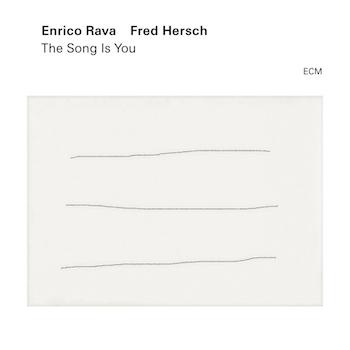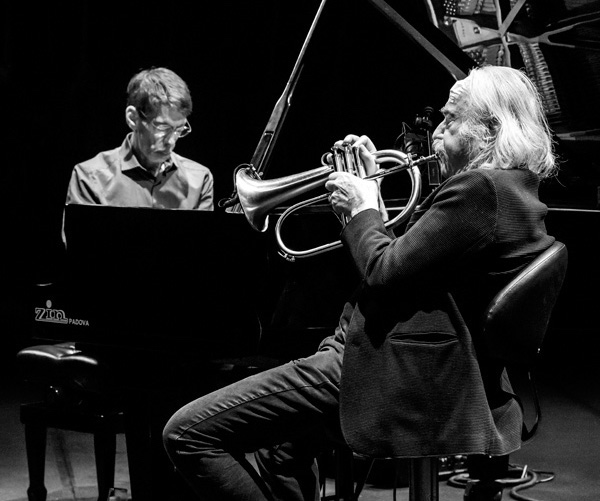Jazz Album Review: Enrico Rava and Fred Hersch’s Winning “The Song Is You” — Suffused With Tact and Grace
By Michael Ulman
The sound of both musicians is indelible: trumpeter Enrico Rava is warm and rounded; pianist Fred Hersch, often icy, is fetching and detailed.
Enrico Rava and Fred Hersch, The Song Is You (ECM)

Recorded in Lugano in November, 2021, The Song is You begins on a melancholy note, with a pristine bell-like introduction by pianist Fred Hersch, who seems to do everything well, and then the theme statement of Antonio Carlos Jobim’s “Retrato em Branco e Preto” by Enrico Rava, who plays at first at a whisper over the ripples of Hersch’s accompaniment. It would be beneficial to listen first to a vocal version. On Jobim’s Elis & Tom, Elis Regina sings the song, which literally travels the rocky road of love. (“I already recognize the rocks along the road,” says one translation.) The lyrics are a series of despairing murmurs uttered by someone who returns obsessively to the same unsatisfactory, but obscurely enchanting, lover: (s)he unwillingly travels the same road. The situation is dismal, but the song is beautiful. It must be a favorite of Rava’s: previously he recorded it in a duet with pianist Stefano Bollani on The Third Man. Here he subtly changes the rhythm of the melody, which rocks between two notes, and suddenly flares at the end of a phrase. His tone is soft-edged, full and appealing. His manipulation of the melody is both unpretentious and remarkable. Hersch is equally commendable. After the initial chorus, in which the melody is stated, he subtly changes the rhythm to introduce the solo. There’s just a hint of a dance, but that perfectly releases the improviser. Later, but with equal tact, Hersch gives his accompaniment a bit of a bounce, as if to offer Rava another choice. Hersch’s lyrical solo, its rhythmic life and subtle references to the melody, gracefully and inventively respects Jobim’s original.
“I’m Getting Sentimental Over You” brings out the duo’s playful side, with Hersch bobbing about the keyboard, Rava poking disjointedly away at the theme statement. The duo also plays a thoroughly original “The Song is You,” a jazz standard that goes back to Frank Sinatra with Tommy Dorsey. Hersch begins with his wind chimes-like sound, tinkling in the treble while Rava winds around him to commence a conversation that seems, at first, to have little to do with the Jerome Kern melody. But it emerges at just about the second minute: Rava plays a gorgeous phrase and then goes silent, as if to hear Hersch’s response before moving on. The pianist becomes more expansive on the bridge, as Rava plays a squiggly phrase upwards before returning to his spacious, warm style. They are willing to open up the seams of a standard and add their own creative elaboration. The album’s second number is a rather dark-toned free piece called simply “Improvisation.”
Each musician has one original in the collection: Hersch’s is his deservedly oft-recorded “Child’s Song,” which received a very different interpretation on the pianist’s Live at Jazz Standard and was performed in a more celebratory style with bassist Charlie Haden on Sarabande. In this version, Hersch is more restrained. His sound is, as always, perfect for the piece. The duet version here moves into daring territory. After the first chorus, something unexpected happens: Hersch begins plucking a note suggested by the rhythm of the piece and Rava improvises over that minimal bit of encouragement. The performance moves into free improvisation with (at times) Rava left to solo without accompaniment. It’s an interesting approach to one of Hersch’s most alluring melodies. Rava’s original is “The Trial,” which he first recorded in 1996 on Noir: Rava Electric Five +1. Hersch plays another chatty — though delicate — introduction to Rava’s entrance.

Trumpeter Enrico Rava and pianist Fred Hersch. Photo: Michele Giotto.
The Song Is You ends with two Thelonious Monk tunes. One of the thrills of Monk’s original version of “Misterioso” (on Blue Note) comes after he plays the amusingly stiff melody. The tune seems to be walking on stilts: at the end of the chorus the rhythm suddenly relaxes and Milt Jackson takes a blues solo. The contrast is extreme: it’s like watching someone running off wearing a tight pair of shoes. Rava and Hersch take a different approach. They play the melody almost in unison. Then, after the first chorus, Rava drops out and Hersch, after a few seemingly tentative notes, plays a spacey version of the sing-song rhythm, with some quotes from Monk’s original mixed into the ruminative solo. In a later chorus, Hersch splashes some chords and refers more directly to the blues. Amazingly, the performance never loses that suggestion of Monk-like whimsy. Rava enters as gently as usual, plays a flaring tone that Hersch imitates, and then — over the chomping four/four by Hersch — emits more typical blues phrases. Gradually the harmonies become more complicated and Rava more animated.
The album adds another surprise, a solo version by Hersch of “‘Round Midnight,” which was the opening number on his Thelonious. The track begins with a splash of an upwards moving arpeggio, followed by a slower moving single note phrase that ends in a trill and a thrice stated downward phrase that sounds like the inverse of the beginning. This gesture is interrupted (the fourth time) and Monk’s melody shyly emerges. This winning recording is suffused with comparable tact and grace throughout. The sound of both musicians is indelible: Rava is warm and rounded; Hersch, often icy, is fetching and detailed.
Michael Ullman studied classical clarinet and was educated at Harvard, the University of Chicago, and the U. of Michigan, from which he received a PhD in English. The author or co-author of two books on jazz, he has written on jazz and classical music for the Atlantic Monthly, New Republic, High Fidelity, Stereophile, Boston Phoenix, Boston Globe, and other venues. His articles on Dickens, Joyce, Kipling, and others have appeared in academic journals. For over 20 years, he has written a bi-monthly jazz column for Fanfare Magazine, for which he also reviews classical music. At Tufts University, he teaches mostly modernist writers in the English Department and jazz and blues history in the Music Department. He plays piano badly.
